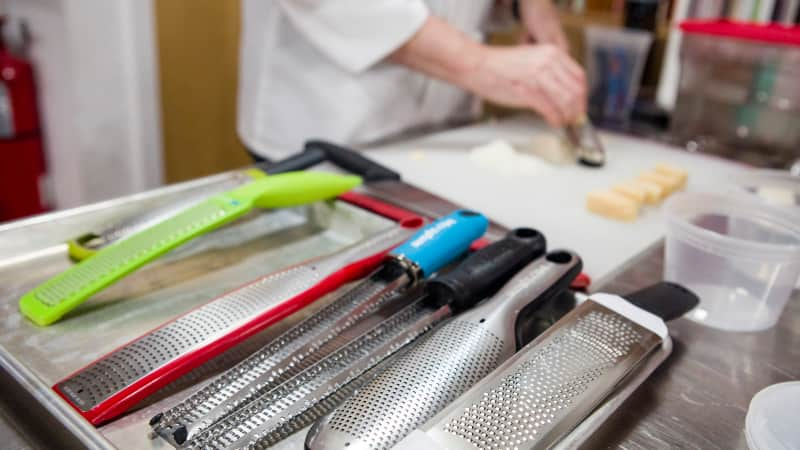The Best Mandolines
Equipment Review
We love the Microplane Classic, but it’s not the only rasp around anymore. Can any of the newcomers top our old favorite?
Published May 1, 2017. Appears in America's Test Kitchen TV Season 21: Grilled Cheese and Tomato Soup

We use rasp-style graters to zest citrus fruits and grate hard cheeses, ginger, shallots, garlic, nutmeg, and more. One manufacturer has ruled the fine-grating roost for years—heck, it invented the game. Grace Manufacturing, the parent company of Microplane, pioneered and patented a special photographic chemical etching process that creates razor-sharp grating teeth. The company initially produced long metal rasps for woodworking but found that consumers were using them in the kitchen, too, so they added a culinary line. But their patent on this process expired in 2011, freeing other manufacturers to create their own versions of this handy tool.
The ideal rasp-style grater would make delicate shreds from a range of foods and would grate said foods evenly. The Microplane Classic Zester/Grater ($12.95) has been our longtime favorite, and while it makes perfect shreds, its narrow (1-inch) grating surface often carves into cheese, leaving behind a trench. This isn’t a deal breaker, but since we last tested, Microplane and other manufacturers have come out with new options, some with wider grating surfaces. Was our old favorite still the best? To find out, we tested it against seven new contenders, priced from $9.99 to $28.00.
Our first test was grating Parmesan cheese. We trimmed eight identical 1-ounce chunks of Parmesan, one for each model. Then we put a cutting board on a large scale so we could be sure to use the exact same amount of pressure for each swipe and started grating. Six of the graters turned in admirable times, taking between 40 and 50 seconds per ounce of cheese. A seventh model took around a minute, and the eighth took a glacial 2 minutes.
The slow model’s grating teeth seemed very tiny, so we measured the teeth on all the graters for comparison. The teeth on the sluggish grater averaged 0.9 square millimeters, while the rest of the graters’ teeth were two to four times as large, at 2.1 to 4.4 square millimeters. Wider teeth allowed the cheese to pass through at a higher rate, making for faster, more efficient grating. Because of its small teeth, the slow model also produced much finer shreds than other graters. We always recommend measuring grated cheese by weight rather than volume, since 1 cup of finely grated cheese can weigh a lot more than 1 cup of coarsely grated cheese. So these finer shreds won’t throw a recipe off as long as you weigh them; we did, however, find them a bit wimpy, and we noted that they disappeared when sprinkled on hot spaghetti.
We also looked at the shape of each grater’s teeth. All the graters except for the small-toothed model had teeth roughly shaped like the lette...

The mission of America’s Test Kitchen Reviews is to find the best equipment and ingredients for the home cook through rigorous, hands-on testing. We stand behind our winners so much that we even put our seal of approval on them.

Hannah is an executive editor for ATK Reviews and cohost of Gear Heads on YouTube.

This is a members' feature.